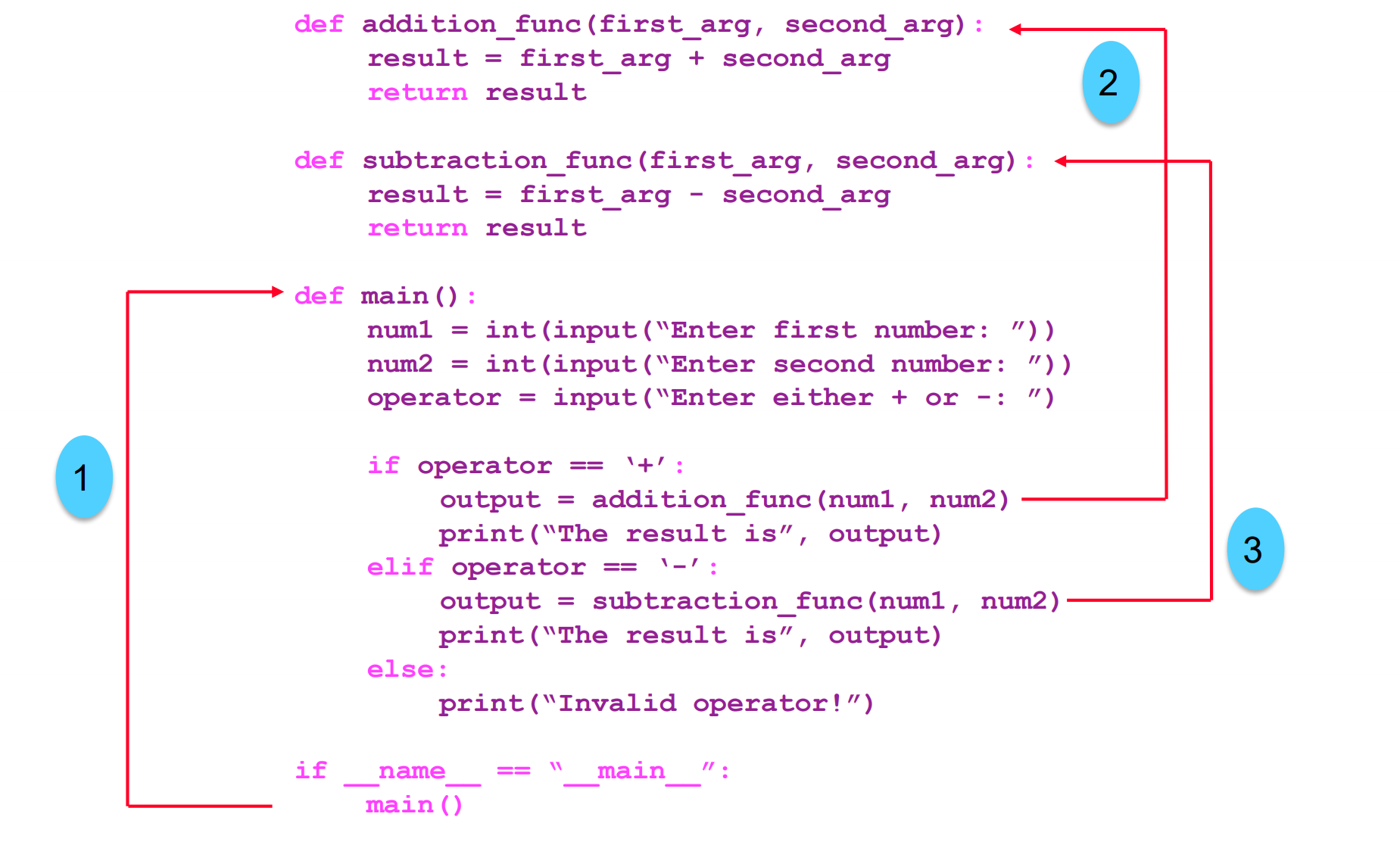人生苦短,我用Python![1]
这次的主要内容主要是介绍Python中的过程分解和文件IO。过程分解包括了函数(function),模块(module)。而文件IO主要是介绍使用Python打开文件并进行读写操作。
过程分解概念
过程分解是一种解决编程问题的策略。它将一个复杂的问题分解为一个一个的小问题,这些小问题更简单,更独立,并且更易于管理,然后通过某种方式来解决这些小问题。通过使用这种方法,编程也会变得简单,更容易理解,更方便做规划和实现。

Fig. 1. 台式机的硬件可拆分也是一种分解思维. Adapted from [2]
要合理的分解这些组件,需要清晰的认识每一个部件的输入和输出。在Python中,过程分解是主要由函数(Function),模块(Module)和类(Class)组成。其中最主要的关键,是提升整体代码的复用性(Reusability)。
函数
函数(Function)是Python中的重要组成部分。函数是一种独立的语句集合,是为完成某一个特定的任务,解决一个特定的问题而定义的。
它可以使用任意数量的参数作为输入,并且返回任意数量任意类型的值。函数需要先创建,然后再进行调用。
函数是对过程或者功能的一种抽象。用户只需要知道怎么把函数用起来去解决问题,而不需要知道函数内部是怎么工作的。
Python中的函数
在Python中,函数是使用关键字def定义的。在函数的开头,需要定义函数的名称和参数(Argument)。函数的名称,参数和返回值构成了函数签名。
函数的组成部分:
- 函数名
- 参数(0或多个)
- 文档注释(可选)
- 函数体
- 返回值(可选)
函数的命名规范:
- 与变量名相同
- 使用
camelCase或者underscore - 必须以字母或者下划线开头,并且只能包含字母、数字或者下划线

Fig. 2. 创建一个函数.
定义一个函数(有参数)
1 | def addition_func(first_arg, second_arg): |
定义一个函数(默认参数)
1 | def addition_func(first_arg=0, second_arg=0): |
调用函数:
- 位置参数(不带关键字): 得按照函数定义的顺序来调用
- 关键字参数: 使用关键字来调用
1
2
3
4
5
6
7
8
9
10
11sum = addition_func(10, 8)
print("The result is", sum)
# The result is 18
sum = addition_func(second_arg=8)
print("The result is", sum)
# The result is 8
sum = addition_func(2, second_arg=8)
print("The result is", sum)
# The result is 10
return和print的区别
return:
return只能用在函数内部,否则会有语法错误- 在一个函数中只会运行一次
return - 在函数里
return后面的代码将不会被运行 - 这个
return的值将会赋予函数的调用者
print:
print可以用在函数外部,也可以用在函数内部- 可以在函数内部执行多次
- 在函数里
print后面的代码可以继续运行 - 这个
print的值将会输出至控制台
main函数
main函数是一个特殊的函数,它指示程序的执行流程,定义了程序的入口点。
1 | def function1(): |

Fig. 3. 函数的执行流程.
模块
Python中的模块(module)是一个包含了定义和语句的Python源代码文件。模块可以被其他程序引用,以使用它们中的函数,类,以及变量。
为了在另一个Python程序中使用别的模块(.py文件):
- 使用
import关键字 - 语法:
import <module_name>import <module_name> as alias
使用已导入模块中的某一个函数:
- 语法:
<module_name>.<function_name><alias>.<function_name>
1 | # Module name: arithmetic.py |
1 | import arithmetic as arm |
为什么要使用函数
- DRY法则: 不要重复你的代码(Don’t Repeat Yourself)
- 将复杂任务分解为一系列简单任务
- 提升代码的可读性
- 代码复用
文件IO
打开文件: open(file, mode)
- 创建一个文件句柄(对文件进行各种操作的对象)
- 两个关键的参数:
file: 文件路径(可以是绝对路径,也可以是相对路径)mode: 文件的操作模式(如下所示)[3]
在中文的Windows系统中,可能需要使用encoding="UTF-8"来指定文件的编码方式,否则可能会出现乱码。因为文件的写入格式和读取格式需要相同。
| mode | 含义 |
|---|---|
"r" |
读取(默认) |
"w" |
覆盖写入 |
"x" |
新建文件并写入 |
"a" |
在文件末尾追加写入 |
"b" |
二进制 |
"+" |
打开文件用于更新(可读可写) |
读取文件
读取一个文件: input_handle = open(file, "r")
input_handle.readline(): 从文件中读取一行(包含\n)for line in input_handle: 遍历文件中的每一行input_handle.readlines(): 读取整个文件,返回一个列表,每个元素为一行input_handle.read(): 读取整个文件,返回一整个字符串
关闭一个文件: input_handle.close()
- 使用完之后,不要忘记关闭文件
1 | # open a file for reading |
也可以使用with关键字
1 | # open a file for reading |
写入文件
打开一个文件用于写入:
open(file, "w"): 覆盖原有文件中的内容open(file, "a"): 在文件的末尾追加写入
写入文件:
file_handle.write(the_line): 写入一行- 注意:
\n作为换行符,需要手动添加到每行的末尾。
1 | # open the input file for reading |
也可以使用with关键词
1 | with open(input_file, "r") as input_handle, open(output_file, "w") as output_handle: |
实践试试
这次我们来试试看使用学到的文件IO和Python函数的知识。使用Jupyter Notebook来试试看吧。
文件基础操作
我们有一个文本文件simple_file.txt,里面包含了以下内容。
1 | 1 2 five |
文件的每一行中包含三个值,前两个是数字,第三个是表示数字的英文字符串,比如说”one”。我们需要做的是将第三个值转换为数字,并且将整个文件的结果写入到output_file.txt里,我们只拿1~5作为例子。
1 | # Open simple_file.txt for reading |
学生信息系统
这里有两个文件,一个是student_data.txt,里面包含着学生的ID,名字和课程。如下所示。
1 | 1,tom,clayton |
另一个文件是enrollment.txt,包含着学生选课的记录,每一行分别是学生ID和课程名称。
1 | 1 mathematics |
我们的任务是建立一个基础的查询系统,这个系统通过输入学生的名字,先判断学生在不在这个系统中,如果在,再输出学生选的课程列表。
1 | def query(student_name): |
括号匹配检查
在求解一个数学表达式的时候,括号代表着计算的更高优先级。比如说:
$$(5+3)+((6-9)/(5+7))$$
其中$(6-9)$和$(5+7)$会在除法运算之前计算。
为了使这个能正常工作,我们需要检查括号是否匹配。匹配的括号意思是,对于每一个左括号都有一个对应的右括号,而且括号也需要正确嵌套。例如,以下是正确的括号字符串:
()()()()()(()())((()))
而以下的字符串是错误的:((()()()()(()((()))(
区分正确的括号匹配是编程语言中的重要部分。编写一个程序,从左到右读取一串括号,并检查括号是否平衡。提示:可以使用一个叫做栈(Stack)的数据结构。
1 | def check_for_balanced_parenthesis(string_of_parenthesis): |
像这样将一段逻辑包装在代码中,可以方便以后在其他地方进行调用,提高代码的可读性和复用性。
参考文献
- [1] B. Eckel, “sebsauvage.net - Python”, Sebsauvage.net, 2021. [Online]. Available: http://sebsauvage.net/python/.
- [2] A. Bell, "Standard 1 - Objective 1: Demonstrate understanding of computer hardware, peripherals and troubleshooting.", slideplayer, 2021. [Online]. Available: https://slideplayer.com/slide/5809212/.
- [3] "Python3 File 方法 | 菜鸟教程", Runoob.com, 2021. [Online]. Available: https://www.runoob.com/python3/python3-file-methods.html.










